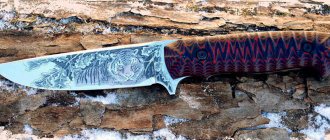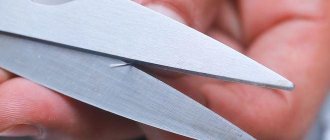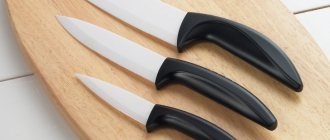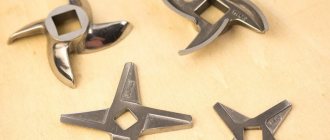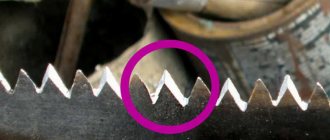Almost every home has an electric assistant that can quickly grind meat into minced meat of any consistency, help squeeze out juice, prepare original cookies or homemade noodles, pasta, and some craftsmen make meat delicacies. During operation, there comes a time when the question arises of how to properly sharpen a knife for a meat grinder. We will tell you what needs to be done for this in our article.
Design and principle of operation
The meat grinder consists of the following units:
- housings with a neck for loading and a cylindrical part for the location of the auger;
- auger;
- a knife attached to the auger;
- a fixedly fixed grille, which is fixed with a nut to the body;
- handles for rotating the auger.
The operating principle is as follows:
- The diced meat is loaded into a special receiving hopper.
- When the handle connected to the auger rotates, the meat from the hopper flows to the cutting tool, passes through it to the mesh holes, and then is fed out.
Meat grinder knives allow you to grind the original products and then use a mesh to give them the desired shape. Grids can be installed with different numbers and diameters of holes.
How often should knives be sharpened?
The frequency of sharpening knives primarily depends on how often the meat grinder is used and how many products it processes. If you use it once every few days, the knives will be sharp for about two months. Of course, new blades will initially last about twice as long. However, then, regardless of quality, they will become dull. Therefore, they will definitely require sharpening.
Remember! A well-sharpened cutting tool saves time using the device; if it is a manual type, then it saves your energy, and if it is an electric one, it saves energy consumption.
Determining when it’s time to sharpen your knives is quite easy. First, the meat will have a much harder time passing through the grill. Secondly, you will hear the screws turning idle during operation. All this suggests that it’s time to sharpen the knives. To do this, you need to disassemble the meat grinder, rinse it thoroughly and dry it. When the device is dry, you can start sharpening the knives. To make the meat grinder work even better, it is recommended to immediately sharpen the grate. If you have a surface grinder available, the easiest way is to use it. Otherwise, you can consider other sharpening methods.
When is sharpening needed?
It is necessary to sharpen the meat grinder if it stops cutting meat, the hopper near the mesh is constantly clogged. Often dull cutting edges are caused by:
- the use of poor steel in the manufacture of a meat grinder;
- grinding meat with bones or tendons;
- storing equipment in a room with high humidity.
In some cases, the wear of the grate does not allow it to come into close contact with the blade, which also negatively affects the quality of meat chopping.
In such situations, the process of self-sharpening blades on a metal grid becomes ineffective. Even minor damage to the edges will reduce functionality. To verify their presence, just unscrew the side cover of the case and inspect the condition of the blades.
Rusted mesh and knife
Sharpening rules
When sharpening meat grinder knives, you need to consider the following rules:
- the abrasive tool must have a flat plane;
- The blades should be lubricated before sharpening to prevent scratches from falling chips or splinters during processing;
- to uniformly remove layers of metal, it is necessary to ensure uniform pressure over the entire area of the blade being sharpened;
- the plane of the metal mesh requires alignment so that when assembling the meat grinder there are no gaps between the rubbing planes above the permissible level.
Tools
To sharpen knives for meat grinders you need to prepare:
- sandpaper;
- abrasive stone;
- sharpening machine;
- lubricant;
- dry rag;
- GOI paste.
Sandpaper
Sharpening methods
You can sharpen a knife from a meat grinder:
- whetstone;
- on the machine;
- sandpaper.
Abrasive stone
Sharpening stones are bars made of natural or artificial stone. Advantages:
- low material cost;
- Possibility of step-by-step quality control of sharpening.
Flaws:
- low processing speed;
- when using low-quality stones with non-uniform grains, damage to the sharpened surface is possible;
- you need a set of stones with different roughness.
You can sharpen meat grinder knives with a sharpener as follows:
- A stone with a roughness of 40–60 microns is taken and placed motionless on the table.
- The stone is lubricated with oil.
- Take a knife and apply it to the stone with its entire working plane.
- Sharpening is carried out - the cutting edge moves in a rotational-circular motion along the abrasive stone.
- The machine is periodically washed to remove chips, then lubricated again and turning is carried out again.
- Similar operations are performed with metal mesh.
Abrasive stone
Grinder
The sharpening machine allows you to fix the abrasive wheel and cutting blades at the desired angles, quickly and safely sharpen edges, and perform a large volume of work with high productivity. To prevent overheating of the steel, the engine speed is adjusted.
When using machines, you need to take into account that they have a number of disadvantages:
- difficulty in controlling the turning process;
- high cost of equipment.
Electric sharpening of a knife from a meat grinder:
- A disk with a suitable roughness is fixed on the machine.
- GOI paste No. 4 is applied to the grinding wheel. Wait the time necessary for the paste to dry.
- The power to the machine is turned on. The speed is selected at which it is possible to perform safe turning without overheating the steel. The sharpening angle is set in the range of 70–80 degrees.
- The cutting edges move along the abrasive surface in a circular motion until the desired level of sharpening is achieved and a smooth, shiny edge is obtained.
- When turning for more than 5 minutes, you need to let the machine run for several minutes at idle speed so that the metal has time to cool.
- In the same way, clean the surface of the mesh until a flat plane is obtained.
Grinder
Emery cloth
Disadvantages of sandpaper:
- when turning, it is difficult to fix the blade and protect it from bends and waves;
- work must be carried out on a flat, durable surface;
- low processing speed.
Sharpening knives with sandpaper:
- Prepare a flat and durable table surface, clearing it of dirt and debris.
- Lay out and level the canvas on the table. It should be secured around the perimeter so that it cannot move or wrinkle during processing.
- Lubricate the surface of the cutting edge and sharpen it in a circular motion.
It is recommended to use fine-grained paper to avoid leaving deep scratches on the metal and to ensure uniform removal of the metal layer over the entire surface. This will increase the processing time, but the quality of sharpening will improve and the risk of errors will be minimal.
Cleansing
Often the mesh rusts. To remove rust, place it in a solution of 9% vinegar for several hours. It can last all night. After this, you may need to rub it lightly to remove the rusty coating. The holes should be cleaned with a toothpick.
After several hours, there will be no rust left in the vinegar, but a dark coating will appear. It also needs to be removed. We clean each hole with sandpaper rolled into a tube. All this can be done manually.
A group of people at high risk of getting sick with coronavirus again has been identified
The doctor called the unusual effect of taking medications by patients with COVID-19
Anti-meteor windows and insulation: how much will a mortgage on the Moon cost?
However, you can speed up the process a little if you use an electric drill. You need to wrap a drill of a suitable diameter with sandpaper, insert it into the drill and clean the holes.
How to sharpen at home?
At home, you can only properly sharpen knives by hand, especially if you have no experience. Processing with sharpeners allows you to fully control the quality of the surface, eliminate defects in a timely manner, and monitor the angle of the blade edge.
Sequencing:
- In the store you need to purchase a sharpening disc with a diameter of 180 mm and a grain size of up to 50 microns.
- Prepare a container into which you can completely immerse the disk. Water is poured into it.
- The disc is securely fixed inside the container.
- Take a knife, place the blade on the sharpening wheel, then make circular movements along its surface. The pressure should be even.
- At short intervals the quality of turning is checked. When the entire surface is shiny, you can proceed to the next stage.
- Perform steps 4 and 5 for steel grating.
- Two sharpened parts are joined.
On the grindstone
You can sharpen knives using whetstones. To do this, we buy a sharpening stone made of corundum from 40 to 60 microns in the store. We make a platform out of boards to strengthen it and provide water supply during work. Having secured the stone on a stand, having previously moistened it with water, we begin to sharpen the moving element, making circular rotational and translational movements. This creates a finely dispersed abrasive paste, which brings the surface to grinding. Periodically rinse the cutter in water. When a shiny surface is achieved, the part is considered sharpened.
Advice from the experts
Masters advise sharpening knives for meat grinders in compliance with the following recommendations:
- the abrasive surface must have a smooth, flat surface;
- It is not recommended to use abrasive tools with large grains;
- to grind the surface, it is necessary to apply GOI paste No. 4 to the surfaces to be sharpened;
- sharpening must be carried out with step-by-step quality control of the edges;
- when processing metal, it is more profitable to choose the minimum frequency of disk rotation on machines;
- when sharpening an edge manually, you need to perform rotational 8-shaped movements on the abrasive wheel;
- It is not allowed to use circles or bars whose surface has uneven wear;
- rubbing parts should be sharpened on the same wheel so that the surfaces have the same roughness and get used faster during work.
The quality of sharpening can be determined as follows: place the thread between the cutting edges and the steel mesh, and then try to cut it. If the attempt is unsuccessful, you should repeat the sharpening procedure again.
Method 3. Bars included in the meat grinder
Often, special sharpening stones are included with the meat grinder, repeating the shape of a four-bladed knife and mesh. Save them and you won't have to look for alternative sharpening options. The manufacturer has thought of everything for you - the bars have all the necessary characteristics to achieve an ideal result.
How to tidy up cutting parts using these tools:
- First sharpen the cross knife. You need to insert a round block into the meat grinder instead of a disk with holes.
- Scroll the river or turn on the device, as if chopping food. The speed should be uniform, increase it gradually.
- Now install the grid knife and the sharpening stone (instead of the cross-shaped part).
- Also rotate the meat grinder handle until the desired sharpness is achieved.





